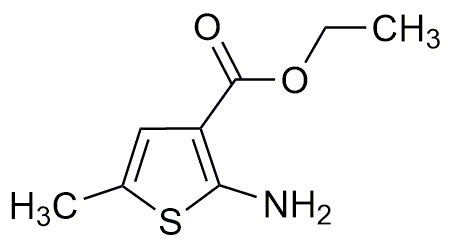Ethyl 2-amino-5-methylthiophene-3-carboxylate is widely utilized in research focused on:
- Pharmaceutical Development: This compound serves as a building block in the synthesis of various pharmaceuticals, particularly in the development of drugs targeting neurological disorders due to its ability to interact with specific receptors in the brain.
- Agricultural Chemistry: It is used in the formulation of agrochemicals, enhancing crop protection products. Its unique structure allows for improved efficacy against pests and diseases, leading to better yields.
- Material Science: The compound is incorporated into the development of novel materials, such as conductive polymers, which are essential for applications in electronics and energy storage devices.
- Biochemical Research: Researchers utilize this compound in studies involving enzyme inhibition, providing insights into metabolic pathways and potential therapeutic targets in various diseases.
- Cosmetic Formulations: Its antioxidant properties make it a valuable ingredient in skincare products, helping to protect the skin from oxidative stress and improve overall skin health.
Informations générales
Propriétés
Sécurité et réglementation
Applications
Ethyl 2-amino-5-methylthiophene-3-carboxylate is widely utilized in research focused on:
- Pharmaceutical Development: This compound serves as a building block in the synthesis of various pharmaceuticals, particularly in the development of drugs targeting neurological disorders due to its ability to interact with specific receptors in the brain.
- Agricultural Chemistry: It is used in the formulation of agrochemicals, enhancing crop protection products. Its unique structure allows for improved efficacy against pests and diseases, leading to better yields.
- Material Science: The compound is incorporated into the development of novel materials, such as conductive polymers, which are essential for applications in electronics and energy storage devices.
- Biochemical Research: Researchers utilize this compound in studies involving enzyme inhibition, providing insights into metabolic pathways and potential therapeutic targets in various diseases.
- Cosmetic Formulations: Its antioxidant properties make it a valuable ingredient in skincare products, helping to protect the skin from oxidative stress and improve overall skin health.
Documents
Fiches de données de sécurité (FDS)
La FDS fournit des informations de sécurité complètes sur la manipulation, le stockage et l’élimination du produit.
Spécifications du produit (PS)
Le PS fournit une description complète des propriétés du produit, notamment sa composition chimique, son état physique, sa pureté et les exigences de stockage. Il détaille également les plages de qualité acceptables et les applications prévues du produit.
Certificats d'analyse (COA)
Recherchez des certificats d'analyse (COA) en saisissant le numéro de lot du produit. Les numéros de lot et de lot se trouvent sur l'étiquette d'un produit, après les mots « Lot » ou « Lot de fabrication ».
Numéro de catalogue
Numéro de lot/série
Certificats d'origine (COO)
Ce certificat d'exploitation confirme le pays dans lequel le produit a été fabriqué, et détaille également les matériaux et composants utilisés et s'il est issu de sources naturelles, synthétiques ou autres sources spécifiques. Ce certificat peut être requis pour les douanes, le commerce et la conformité réglementaire.
Numéro de catalogue
Numéro de lot/série
Fiches de données de sécurité (FDS)
La FDS fournit des informations de sécurité complètes sur la manipulation, le stockage et l’élimination du produit.
DownloadSpécifications du produit (PS)
Le PS fournit une description complète des propriétés du produit, notamment sa composition chimique, son état physique, sa pureté et les exigences de stockage. Il détaille également les plages de qualité acceptables et les applications prévues du produit.
DownloadCertificats d'analyse (COA)
Recherchez des certificats d'analyse (COA) en saisissant le numéro de lot du produit. Les numéros de lot et de lot se trouvent sur l'étiquette d'un produit, après les mots « Lot » ou « Lot de fabrication ».
Numéro de catalogue
Numéro de lot/série
Certificats d'origine (COO)
Ce certificat d'exploitation confirme le pays dans lequel le produit a été fabriqué, et détaille également les matériaux et composants utilisés et s'il est issu de sources naturelles, synthétiques ou autres sources spécifiques. Ce certificat peut être requis pour les douanes, le commerce et la conformité réglementaire.


